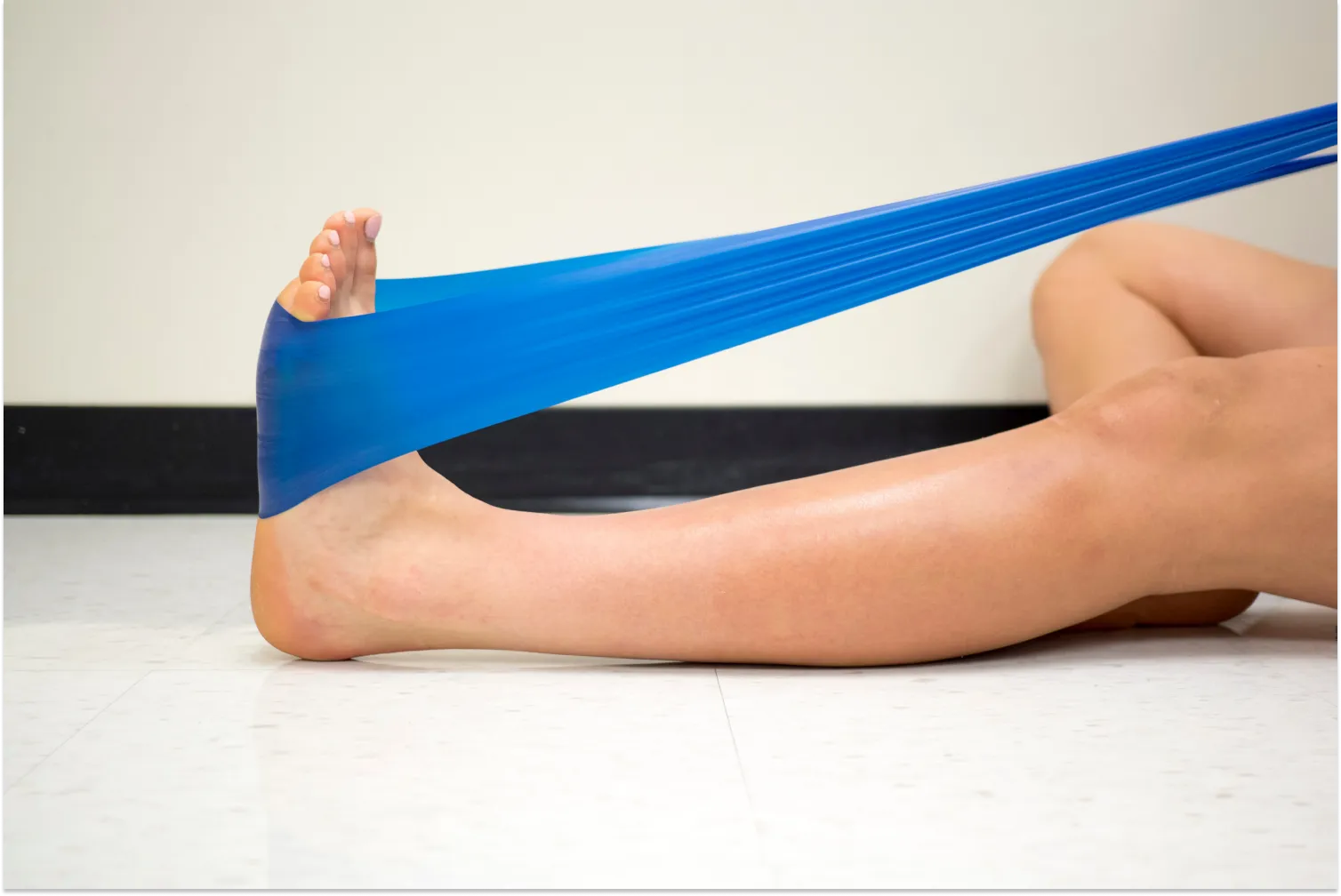Medically Reviewed By | Johannah Gregg, DNP FNP-C
Every step we take is a testament to our body's incredible design, with our ankles playing a pivotal role in ensuring movement without discomfort. The ankle, a sophisticated hinge joint, plays a fundamental role in walking, running, and many athletic activities.
However, its importance often goes unnoticed until foot pain and mobility issues begin to surface. In this guide, we'll explore the profound connection between ankle mobility and foot comfort and delve into exercises that can help alleviate pain and enhance mobility.
What Is the Connection Between Ankle Mobility and Foot Pain?
Our ankles are not just simple joints but the bridge between our feet and the rest of our body. Limited ankle mobility can lead to a chain reaction of compensatory movements in our feet, knees, and hips.
Such compensations can result in foot pain, plantar fasciitis, and other related issues. A restricted ankle can reduce the efficiency of our natural gait, placing undue stress on the foot.
Poor blood flow, a key component in joint health, can also exacerbate these problems. The relationship between the ankle and foot is symbiotic: when one suffers, the other feels the strain. By fostering better ankle mobility, we inherently promote healthier foot mechanics, reducing pain and improving overall functionality.
What Are the Benefits of Improving Ankle Mobility?
Ankle mobility isn't merely about avoiding foot pain; its implications can be felt throughout our body, influencing our overall physical health.
By enhancing ankle flexibility, you can experience:
-
Reduced Foot Pain: A mobile ankle means a happier foot. “Proper ankle movement improves the overall biomechanics of the foot and ankle allowing your body to move how it most naturally wants to. This impacts how pressure is absorbed and distributed throughout the foot during activities. Proper ankle mobility can optimize this for your body, helping present painful conditions such as plantar fasciitis,” highlights Katelyn Panawash, Doctor of Physical Therapy (DPT) and Board Certified Neurologic Clinical Specialist (NCS).
-
Enhanced Athletic Performance: Athletes, from runners to weightlifters and gymnasts to golfers, can attest to the importance of ankle flexibility. It improves the range of motion and allows for more powerful and efficient movements.
-
Lower Risk of Injury: A limber ankle can absorb shocks better and adjust to uneven terrains, reducing the chances of injuries like sprains. If you sprain your ankle, you may need to wrap it to support the ankle further.
- Improved Posture and Balance: Ankle stability directly affects our balance, affecting our posture and ensuring we stand tall and confident. “One of our body's first natural balance tools is called ankle strategy. It is the ability of the muscles in the feet and ankles to work synergistically in response to internal or external forces to keep us from falling,” adds Panawash.
What Are 6 Ankle Mobility Exercises?
Ankle exercises are essential to enhance movement and alleviate foot discomfort. Let’s look at several ankle mobility exercises tailored to bolster flexibility, strength, and overall joint health. These exercises will help you discover the transformative power of targeted ankle routines.
1. Ankle Circles
Sit comfortably and extend one leg. Rotate your foot, making circles with your toes. Do this clockwise and then counter-clockwise for 30 seconds each. This exercise improves overall ankle mobility.
“To progress this activity and improve your brain and body connection (motor control) practice drawing the letters of the alphabet with each ankle. You can do the lower case and/or upper case alphabet. Being thoughtful and paying attention to the movement works at improving that brain-body connection,” highlights Panawash.
2. Dorsiflexion and Plantar Flexion Stretches
Using a resistance band around your foot, push your foot forward and then pull it back towards you. This exercise strengthens the front and back muscles of your shin.
“To do this start in a stance with your feet should width apart for balance. Then with one leg step forward (not quite as far as a lunge). Then control a slow lean/shift weight forward into that leg. You should feel a stretch in the back of the back leg and should feel the ankle working in the front leg. You don't even need the resistance band to make this effective,” says Panawash.
3. Calf Raises and Drops
Standing on a step or platform, rise onto your toes and slowly lower your heels below the step level. This not only improves mobility but also strengthens the calf muscles.
“To start hold a wall or railing to help you keep your balance. As you improve, you can work towards not holding on to anything. When you can easily do 20 reps in a row, it might be time to try doing one leg at a time. Just like before, start with holding a wall or railing for balance as you work on this exercise,” Panawash adds.
4. Towel Scrunches
Place a towel on the floor. Using only your toes, try to scrunch the towel towards you. This exercise is excellent for strengthening foot muscles and enhancing toe flexibility.
5. Resistance Band Exercises
Anchor a band and loop it around your foot. Move your foot side-to-side against the band's resistance. This exercise targets the muscles on the sides of your ankle.
6. Plyometric Ankle Hops
Stand with feet shoulder-width apart. Perform small, controlled hops, focusing on using your ankles' range of motion rather than bending the knees significantly. This plyometric exercise strengthens the ankle muscles and enhances proprioception, aiding in better balance and injury prevention during dynamic movements.
“Remember playing hopscotch as a kid — it’s an excellent way to build ankle strength, stability, and control,” Panawash highlights.
What Are Additional Exercises for Ankle Mobility?
Diversifying your ankle mobility routine is key to achieving comprehensive benefits. Beyond the previously mentioned exercises, consider integrating heel-to-toe walks, which enhance balance and coordination. Inversion and eversion stretches target the often-neglected sides of the ankle, fortifying them against potential injuries.
Seated calf stretches are excellent for lengthening and relieving the calf muscles, further supporting the ankle. When coupled with dedication and consistency, these exercises contribute to building a robust foundation for a mobile and resilient ankle, preparing it for life's dynamic challenges.
How Can Incrediwear Support Your Routine?
In our pursuit of optimal ankle health, it's crucial to utilize tools that amplify our efforts. Enter Incrediwear. Incrediwear products release negative ions when stimulated by body heat by harnessing the power of semiconductor elements within the fabric.
This results in an activation of cellular vibrations that support blood flow, thereby soothing discomfort and maintaining recovery. This isn't just about providing support; it's about supercharging the body’s natural healing process.
By incorporating Incrediwear into your routine, you can look forward to:
-
Healthy Blood Flow: Increasing circulation brings more oxygen and nutrients to your ankles, expediting the healing and recovery process.
-
Soothed Discomfort: With healthy blood flow comes calmed irritation, ensuring your exercises are more effective and discomfort-free.
- Support Without Compression: Remember, Incrediwear is not a mere compression product. It's a fusion of technology and well-being tailored for those committed to optimal health.
In terms of ankle health, the Incrediwear Ankle Sleeve can help soothe swelling and discomfort and support mobility in your ankle or foot.
Wrapping Up
Though often overlooked, our ankles play a pivotal role in our day-to-day activities, gracefully shouldering the weight of our every stride and action. As we get older, giving our ankles the care and attention they deserve becomes imperative.
By embracing targeted exercises complemented by the groundbreaking technology of Incrediwear, we pave the way for a future of mobility, freedom from discomfort, and holistic well-being. Investing in our ankle health is one important way to ensure a future of boundless movement and unparalleled comfort.
Sources:
Plantar fasciitis - Symptoms and causes | Mayo Clinic
Stretching: Focus on flexibility | Mayo Clinic
Inflammation: What Is It, Causes, Symptoms & Treatment | Cleveland Clinic
Read more

Medically Reviewed By | Dr. Kate Panawash, PT, NCS, DPT Yoga practice is a form of exercise for supporting your strength and helping you live a healthier life, but it can serve many excellent purpo...

The ubiquitous use of keyboards in modern life has brought about an unforeseen consequence: typing-related injuries. As our reliance on computers grows, understanding the risks associated with repe...






Leave a comment
All comments are moderated before being published.
This site is protected by hCaptcha and the hCaptcha Privacy Policy and Terms of Service apply.